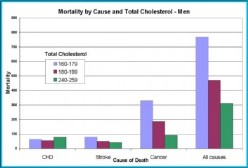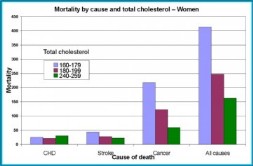Low Cholesterol Increases Death Rates
Part 1: Introduction
After all that you have heard about cholesterol, you may be surprised to learn that as you age, your chances of an early death rise if your total cholesterol falls.
This disturbing finding was discovered over twenty years ago and published in the Journal of the American Medical Association.[1]
It showed clearly that after the age of 50, heart death rates increased by 14% for every 1 mg/dL (0.026 mmol/L) drop in total cholesterol levels per year.
Individuals whose total cholesterol levels drop 14 mg/dL (0.364 mmol/L) during 14 years can expect an 11% higher death rate than if the level had remained the same or risen.
In a British context, if your cholesterol level drops from 6.0 mmol/L to a 'healthy' 5.0 mmol/L, your relative risk of death is four times greater!
Confirmation
European-wide research on patients with chronic heart failure also found that those who had a higher total cholesterol lived longer. The chance of survival increased by 25% for each increase of 1.0 mmol/L (40mg/dL) in total cholesterol.[2]
The Japanese confirmed these results with a study conducted at Kyushu University. This concluded that '[Total cholesterol] level reduction from 240-259 mg/dl [6.24-6.73 mmol/L] to 160-199 mg/dl [4.2-5.2 mmol/L] leads to an increase in total mortality rate in the Japanese population'.[3]
The figures from this huge study of 55,000 men and women aged between 35 and 70 are in the two graphs below.
In both of these graphs you will note that cholesterol has very little effect on deaths from coronary heart disease (CHD): the number of deaths rise as cholesterol both rises and as it falls. But overall, the effects are small. That is not the case with the other causes of death. In strokes, cancer and from all causes of death combined, it is very clear that the lower your cholesterol is, the more likely you are to die. This is the same for all ages between 35 and 70, and for both sexes.
These graphs should provide a reason for those who are trying to get their cholesterol down to reconsider that decision.
Heart failure
Recovery from existing heart failure also takes longer if you have lower cholesterol.
In an analysis of 1,134 patients with heart disease, low cholesterol was associated with worse outcomes and lower survival rates, while high cholesterol improved survival rates.[4] This study also showed that high cholesterol among patients was not associated with high blood pressure, diabetes, or coronary heart disease.
So if your doctor tells you that your cholesterol is high and he wants to put you on cholesterol-lowering drugs, you might like to reflect on the fact that taking them may well shorten your life - particularly if you approaching or above the age of 50.[5] Which all rather makes a nonsense of the cholesterol hypothesis.
Cholesterol is only a 'risk factor' for coronary heart disease - and even that risk factor disappeared when a narrow age group was considered. It doesn't cause the condition; it merely shows some statistical association with various coronary events.
In this respect it is similar to several hundred other 'risk factors'. A diagonal earlobe crease and premature baldness are also 'risk factors' for heart disease but correcting them with plastic surgery or a hair transplant is not going to prevent coronary disease - and neither does lowering cholesterol.
In the next Parts we will look at death rates and choloesterol levels in different age groups.
References
1. Anderson KM, et al. Cholesterol and Mortality. 30 Years of Follow-up from the Framingham Study. JAMA 1987; 257: 2176-2180.
2. Rauchhaus M, Clark AL, Doehner W, et al. The relationship between cholesterol and survival in patients with chronic heart failure. J Am Coll Cardiol 2003; 42: 1933-40.
3. Kame C, Babazono A, Yamamoto E. [Estimation of effect of lipid lowering treatment on total mortality rate and its cost-effectiveness determined by intervention study of hypercholesterolemia] Nippon Eiseigaku Zasshi 2007; 62: 39-46.
4. Horwich, et al. Low serum total cholesterol is associated with marked increase in mortality in advanced heart failure. J Cardiac Fail 2002; 4: 216-224.
5. Steffens DC, McQuoid DR, Krishnan KR. Cholesterol-lowering medication and relapse of depression. Psychopharmacology Bull 2003; 37: 92-98
Part 1. Introduction | Part 2: Deaths in the young | Part 3. Middle aged deaths | Part 4: Deaths in the Elderly
Related Articles

 HOME
HOME




